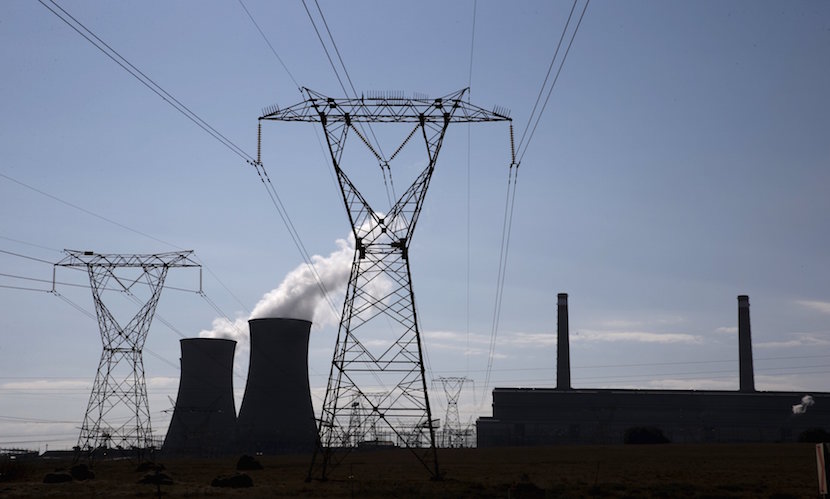It’s a reflection of South Africa’s current state of depression that most citizens missed the obvious bright spot. There has been a massive improvement in the supply of electricity since former Transnet CEO Brian Molefe moved into the hot seat at state-owned Eskom. Memories of morale-sapping load-shedding are fading after months of consistency. Molefe, a rare success in the ANC’s destructive policy of cadre deployment, still follows the party line on a proposed $100bn nuclear fleet. But outside of that, his management of the power utility has succeeded in the only place it really matters. As you can read from their article, the influential Matthew Winkler, until recently Bloomberg’s global editorial chief, and the local office’s energy specialist Paul Burkhardt are suitably impressed. But not nearly so much as members of a grateful nation who learnt the hard way that without electricity, no modern economy functions. – Alec Hogg
By Paul Burkhardt and Matthew Winkler
(Bloomberg) — A plan to reform state-owned power company Eskom Holdings SOC Ltd. and provide more electricity to South Africa and its economy is starting to show results, according to Chief Executive Officer Brian Molefe.
With new leadership in place, the company that supplies about 95 percent of power to Africa’s most-industrialized economy is following a strict maintenance program to avoid managed blackouts, will ask the regulator for more certainty on the tariffs it can charge and will accelerate its delayed program to build generation capacity, said Molefe, 48. He was confirmed as CEO of the utility in September after acting in the position since April.

Eskom is struggling to meet demand after decades of underinvestment and delays in completing new plants. While it imposed power cuts on about 100 days earlier in the year, there have been no significant blackouts in the past three months.
“The strategy is beginning to bear fruit,” he said in an interview at the company’s Johannesburg headquarters Nov. 11. “It’s about the way that we execute maintenance in a disciplined way to make sure that we don’t do load-shedding,” Molefe said, referring to rolling blackouts. The plan is known internally as Tetris.
Read also: Eskom ‘blackout’ free until April? Pushing nuclear expansion.
Eskom has long-term borrowings of about $23.4 billion, exceeding 99 percent of the 170 companies in the FTSE/JSE Africa All Share Index, according to data compiled by Bloomberg. Ratings companies and investors that Molefe met with in London last week hadn’t been aware of some of the progress the utility has made, he said.
Prior to joining Eskom, Molefe was CEO of South Africa’s ports and rail company, Transnet SOC Ltd. Since his departure, total returns on the transport operator’s bonds have declined more than those of the power utility, suggesting investors are buying into his strategy.
Tariff Approach
The company’s also battling to fill a revenue shortfall of 225 billion rand for the five years through 2018, the result of the energy regulator’s decision to grant the company half of the annual average tariff increase of 16 percent sought for the period.
Molefe has changed the power company’s strategy from seeking a cost-reflective tariff, which he estimates would amount to an 80 percent increase, to a longer-term structure.
“Our idea is to go back to the authorities, to the regulator next year, and find a way that will work that will give us — as South Africa — certainty of tariffs, maybe over a 10-year period,” he said. “We will try and fit into those tariffs and those revenue lines to keep the business liquid.”
Read also: Eskom must invest another $15bn by 2022 to keep electricity grid working
The government was slow to recognize the increase in generation needed to meet demand in post-apartheid South Africa. Eskom in 2007 approved the construction of the Medupi and Kusile plants, about 4,800 megawatts each, making them the biggest coal-fired facilities on the continent when complete.
Construction and planning problems, together with labor unrest have contributed to a four-year delay in the startup of the plants. Molefe intends to stop the moving deadlines and deliver units ahead of the current schedule.
Nuclear Plan
South Africa also expects to procure as much as 9,600 megawatts of nuclear power, with Eskom acting as the owner and operator. Price-tag estimates for as many as eight reactors range from $37 billion to $100 billion. The lifespan of an atomic plant, which has low operating costs relative to a coal- fired facility, is about of 60 to 80 years, and it can be paid off in two decades, Molefe said. Costs to run the utility’s Koeberg station near Cape Town, the continent’s sole nuclear facility, are among the lowest in the utility’s generation fleet, he said.
Read also: German Energy Minister Baake tells SA: Build your renewables – dump nuclear
“We need nuclear in the generation mix actually to reduce tariffs,” Molefe said. “The question is how we get through the initial capital phase. Rudimentary financial modeling shows that nuclear can actually repay the capital cost over a 20-year period.”
While Molefe still sees a risk of rolling power cuts in the next few years, he expects to complete all aspects of his plan by 2022.
Brought over as acting CEO in April from Transnet, Molefe saw past the operational issues and management shakeups to some positive aspects of the utility.
“Part of the reason I agreed to take the job is because actually, having looked at Eskom closer, I didn’t think it was as bad a position as people had perceived it to be,” he said.

